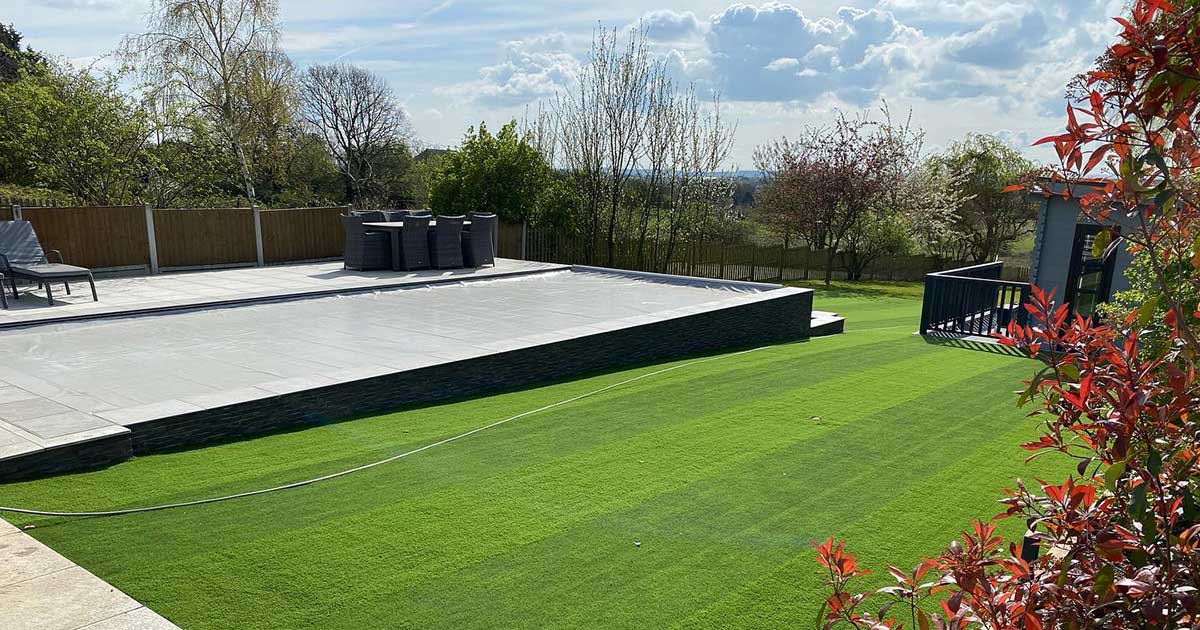We Supply. We Install. We Do it All.
Essex Artificial Grass Experts
You’ve got your brand-new artificial lawn installed and it’s looking great. All your guests have complimented how vibrant it looks and your neighbours have been eyeing it enviously over the garden wall.
While one of the major advantages of artificial grass is the fact it’s low-maintenance—with no need to mow, water, or fertilize it—there are still a few things you can do to make sure your fake lawn always looks its best.
Here’s everything you need to know about cleaning artificial grass.

The first step in cleaning artificial grass is to remove any debris or mud from the surface. This is best done with either a tough-bristled brush, a garden rake (as long as it’s plastic, not metal), or a leaf blower.
This will remove any dry leaves, twigs, dust, dirt, pet hair, and other garden collateral. If you don’t do this, any debris could start to decompose and encourage the growth of moss or weeds as well as stop your lawn from draining effectively. In the long term, this could damage your artificial lawn.
This can be done on a weekly basis or whenever your fake grass looks like it could do with a tidy-up.
If anything heavy has been left lying on your lawn, you may notice it looks a bit flat. Simply rake or brush against the grain to spruce it up.
For a more thorough clean, give your fake lawn a spray down with cold water from the garden hose. This will help to remove more stubborn dirt.
But don’t be tempted to use a knife or anything sharp to scrape or lever sticky spills from drinks or food. This could damage it. Instead, opt for something blunt. A toothbrush could do the trick.
This should be done on a monthly basis to make sure your artificial grass always looks in tip-top condition and to help it last a long time.
Sometimes, plain water doesn’t quite cut it, especially if you’ve noticed a lingering smell from cat or dog urine. The best pet-friendly artificial grass products are simple soapy solutions, such as washing up liquid and warm water, or a water-vinegar mixture at a ratio of 1:1.
Vinegar is great because it’s not dangerous to either pets or children and is also a natural deodourizer. And both soap and vinegar are the best options for cleaning artificial grass because they don’t discolour the lawn. Specialist artificial grass cleaner is another option.
Give the area a scrub with the solution on a sponge or soft cloth. Then use the garden hose to rinse.
There’s no need to dry your artificial grass. In fact, applying heat in any form to the lawn could damage it. The same goes for vacuum cleaning. Instead, just let it dry naturally.
It’s best not to power wash your artificial grass as it can remove the sand infill. However, if your artificial grass was installed without the use of infill, then power washing can be an effective way to clean it. Just be sure to remove any pet waste beforehand.
You should clean artificial grass on a weekly basis with water. Giving your lawn a brush once a week is also good for areas with high traffic. A leaf blower or rake will also do the trick. Once a month, it’s also a good idea to do a deep clean with a soapy or water-vinegar solution. This will keep your artificial turf looking good for a long time. Never hoover your artificial grass as the suction power will damage your lawn.
You can use soapy water, such as a mixture of washing-up liquid and warm water, or another disinfectant solution, to clean artificial grass. This is an easy way to keep your artificial lawn fresh and sanitary.
To get a dog urine smell out of your synthetic grass, the best thing to do is to start by washing the lawn down with your garden hose before spraying it with a disinfectant or soapy solution.
A water-vinegar mixture can also be effective at removing odours and stubborn stains. It’s non-toxic and safe for children and pets. Then rinse the area with clean water from a hose again.
Like this article?
